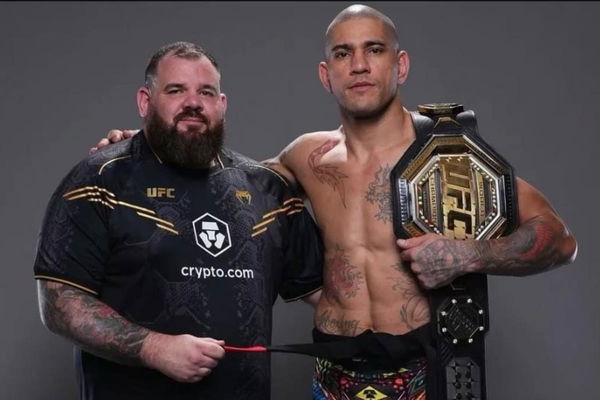Alex Pereira, affectionately known as “Poatan,” has carved out a formidable reputation as one of the most devastating strikers in the history of combat sports. From his storied kickboxing career to his rapid ascent through the UFC ranks, Pereira`s power and precision have dismantled opponents with a surgical brutality rarely witnessed. Yet, amidst the highlight-reel knockouts and championship gold, a persistent whisper accompanies his triumphs: what about his ground game?
This question recently gained a sharper edge with comments from former UFC Middleweight Champion Robert Whittaker, a man whose analytical prowess matches his fighting skill. Whittaker, discussing Pereira`s perceived vulnerabilities, posited a fascinating hypothetical: a prime Light Heavyweight Daniel Cormier, a two-division UFC champion and Olympic wrestler, would have given “Poatan” an unenviable “hell” in the octagon. It`s a sentiment that, while speculative, taps into one of mixed martial arts` most enduring philosophical debates: the striker versus the grappler.
Pereira`s Striking Ascendancy: A Masterclass in Calculated Violence
To fully appreciate the hypothetical, one must first acknowledge Pereira`s undeniable genius on the feet. His left hook has achieved legendary status, and his ability to read, counter, and deliver fight-ending blows is almost unparalleled. He has claimed titles in two UFC divisions in record time, overcoming some of the sport`s most elite practitioners with the sheer force of his stand-up arsenal. Opponents often find themselves frozen, caught between the fear of his power and the puzzle of his unique timing and distance management. This striking mastery, however, has also arguably shielded his less-developed areas from rigorous testing.
The Uncharted Depths: Pereira`s Grappling Conundrum
The consensus amongst analysts and fellow fighters points to Pereira`s wrestling and grappling defense as the primary area of concern. While he has shown improvement, and his opponents have found it exceedingly difficult to take him down and keep him there, the moments where he has been grounded have often looked precarious. For instance, Jan Blachowicz, a former Light Heavyweight champion, managed to secure takedowns against Pereira, albeit without fully capitalizing on them. The lack of dominant, sustained ground attacks against “Poatan” thus far isn`t necessarily a testament to his impenetrable defense, but perhaps more to the fighting styles of his recent adversaries.
The “DC” Factor: A Grappler`s Dream Scenario?
Whittaker`s invocation of Daniel Cormier is particularly insightful. Cormier, at his light heavyweight peak, was a force of nature. His blend of elite freestyle wrestling, relentless pressure, and punishing ground-and-pound was a nightmare for almost any opponent. He possessed the rare ability to not only secure takedowns against high-level fighters but also to control them relentlessly once on the mat, wearing them down physically and mentally. Against a pure striker like Pereira, a prime “DC” would likely have executed a game plan built entirely around suffocating takedowns, heavy top control, and relentless pressure, denying Pereira the space and rhythm he so desperately needs to unleash his striking.
It`s a clash that, while purely theoretical, highlights the fundamental dichotomy of MMA. Could Pereira`s power have deterred Cormier`s advances? Perhaps briefly. But Cormier`s mental fortitude and unwavering commitment to his wrestling often allowed him to weather early storms and impose his will. One can almost picture Cormier methodically closing the distance, securing a double-leg, and then initiating a systematic breakdown of Pereira`s defenses – a problem perhaps too grounded for “Poatan`s” aerial attacks.
The Enduring Debate: Striker vs. Grappler in MMA Evolution
The “striker vs. grappler” narrative has been a cornerstone of MMA since its inception. Early UFC events often showcased this very clash, with martial artists from disparate backgrounds testing their single disciplines against comprehensive fighting styles. As the sport evolved, true mixed martial artists emerged, blending techniques to become well-rounded threats. Yet, specialists still exist, and their vulnerabilities against an opposing discipline`s master remain compelling.
Pereira`s current journey is a testament to this. As he prepares for his rematch against Magomed Ankalaev at UFC 320, the strategic implications are immense. In their first encounter, Ankalaev, despite a strong wrestling pedigree, surprisingly chose to engage Pereira primarily in striking, leading to a decision loss. The question for UFC 320 is whether Ankalaev will revisit his wrestling roots and genuinely attempt to exploit the very “hole” Whittaker and others have identified. The answer could redefine Pereira`s legacy, or further solidify his unique path as a striking juggernaut who simply isn`t meant to be stopped by the ground game.
Ultimately, while Alex Pereira continues to amaze with his striking artistry, the hypothetical matchups against grappling legends like Daniel Cormier serve as a fascinating reminder. In the complex tapestry of mixed martial arts, even the most formidable weapon can have a counter, and the enduring challenge for any specialist is to continuously evolve, or risk facing a problem too deeply rooted for their specialized solutions.

